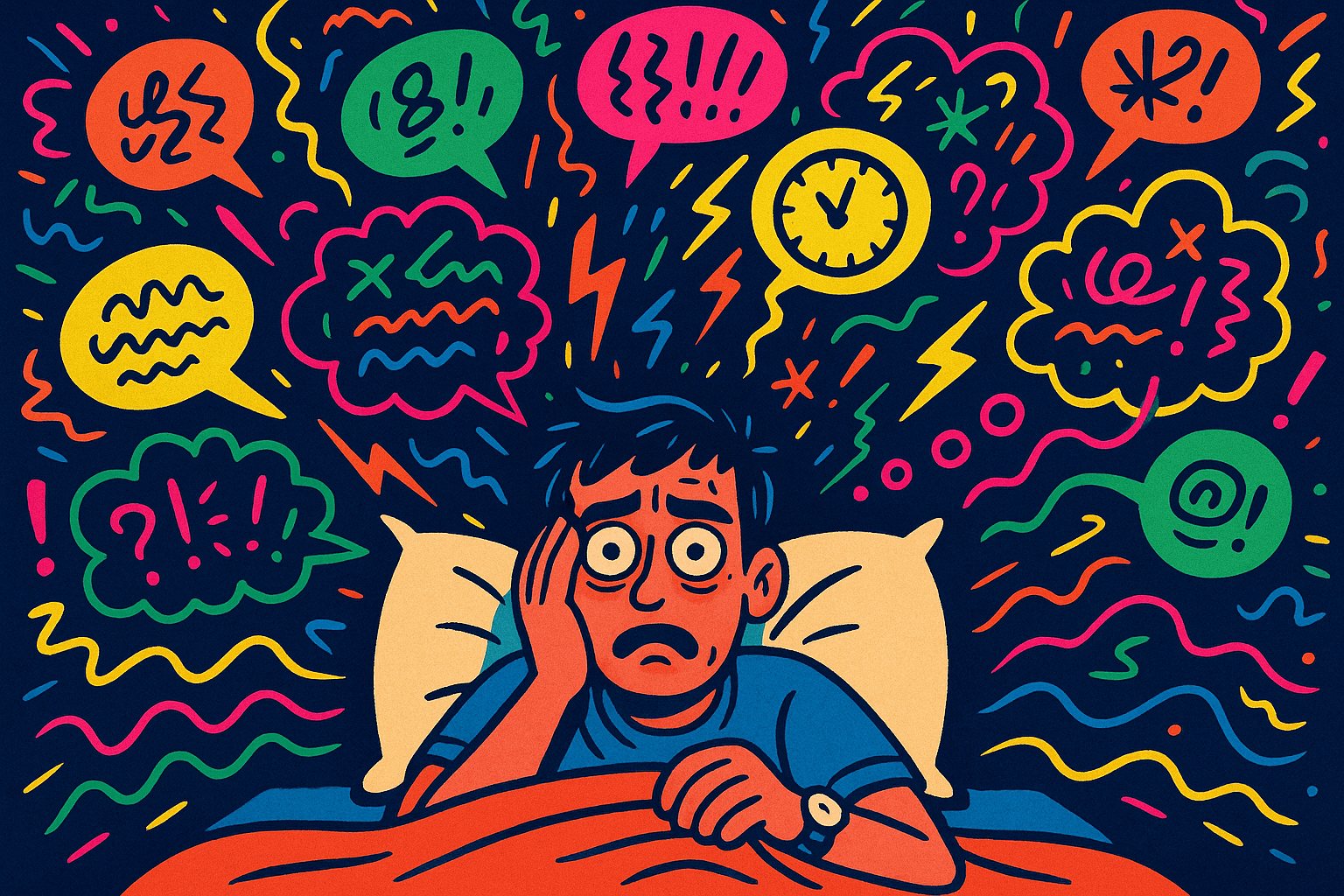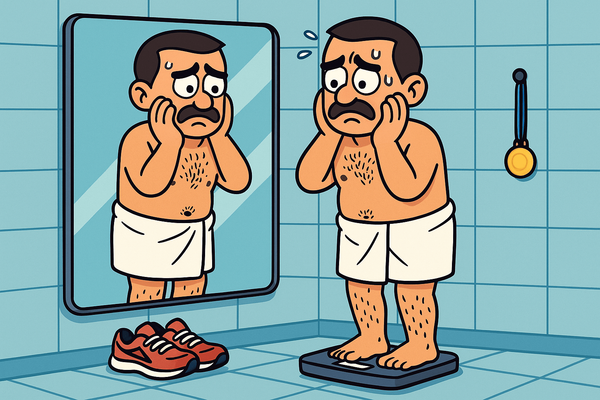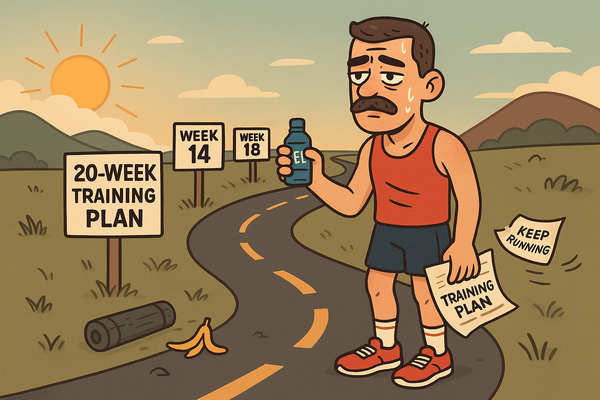Managing anxiety with exercise
You can’t stop your brain from sprinting forever. But you can make it too tired to keep lapping you.

Feel like your brain is running sprints at 3am while your body sits perfectly still? Heart pounding, shallow breathing, skin buzzing with dread — all while you’re just trying to sit through a meeting or brush your teeth? Chances are you’ve got a bit of anxiety.
What anxiety really feels like
Anxiety is when your body acts like you’re being chased by wolves while you’re just trying to send an email. It’s your brain refusing to shut up, creating catastrophes out of nothing, replaying arguments from five years ago, and convinces you that forgetting to answer a text will collapse your entire life. Anxiety isn’t dramatic panic attacks every day. Most of the time, it’s just the exhausting background noise of “something is wrong” when nothing actually is.
What happens to your body when you’re anxious
Your brain and anxiety
When anxiety hits, your body floods with cortisol and adrenaline — stress hormones designed to save your life in an actual emergency. They raise your heart rate, speed up your breathing, and get your muscles ready to run or fight. It’s an extremely useful response if you’re being chased by a bear. Less useful if you’re lying in bed trying to sleep.
Your body has hit the panic button and OH MY GOD WHY ARE YOU NOT PANICKING?! Your chest tightens, your pulse races, and your thoughts spin — your brain thinks you’re in mortal danger, and it’s offended your body is not acting like it so now it’s spiralling.
The physical response to anxiety
Anxiety doesn’t always just sit in your head — it can crawl through your whole body. You feel restless, like you have to move. Your breathing gets shallow. Your stomach clenches. You might sweat, twitch, or feel like your skin is buzzing. Your body thinks you’re in danger, but you’re just stuck in your office chair trying not to scream.
The mental response to anxiety
Anxiety fills your brain with disaster scenarios. Every small decision spirals into catastrophe. You convince yourself you’ve ruined your future because you sent an email with a typo. You rehearse conversations with strangers who don’t even exist, spending hours living through disasters that never actually happen. You know it’s irrational — but that doesn’t make it stop.
How exercise helps manage anxiety
Exercise won’t fix the reasons you’re anxious, or suddenly turn your brain into a Zen garden. What it does is give your body a way to use up all the stress hormones that are chewing you alive. It turns invisible danger into something you can actually outrun.
Physiologically, exercise hijacks the same system anxiety abuses. Where anxiety floods you with cortisol and adrenaline and then leaves you stewing in it, exercise forces those hormones into action and burns them off. Instead of your body panicking about an imaginary bear, you give it a real one to run from.
- It gives your fight-or-flight system an outlet. Those stress hormones finally get used for their intended purpose, instead of leaving you jittery and sleepless.
- It takes the edge off physical symptoms. Sweaty palms, racing heart, shallow breathing — exercise makes you feel them on your own terms, and shows they’re not deadly.
- It forces regulated breathing. Running, lifting, cycling, they all demand deeper, steadier breaths to keep you moving. That rhythm isn’t just mechanics; it’s a built-in reset for your nervous system. Yoga figured this out a few thousand years before sports science gave it a name: pranayama — control of breath as control of mind. Whether you call it science or philosophy, the truth is the same: when you master your breath, you stop anxiety from mastering you.
- It wears you out. Post-exercise fatigue is often the only kind that knocks the shit out of anxiety.
- It distracts your brain. Counting reps, watching kilometres tick up, focusing on movement instead of spirals. Even for just a brief period, the noise has somewhere else to go.
Anxiety feeds on energy with nowhere to go. By turning panic into movement, you will invite a level of calm to your body. Sometimes that’s only a brief two minutes, other times you might push yourself so hard that the sheer exhaustion sends you to sleep for a full 8 hours. If that’s the case, then mission accomplished.
Practical tips for exercising with anxiety
- Start with rhythm. Anxiety thrives on chaos and racing thoughts. Repetitive, rhythmic movement like running, cycling or swimming creates a steady sensory input your brain can “sync” with. That rhythm acts like a metronome, pulling your attention away from spirals.
- Go for intensity. Your body is begging you to fight or flight, so do it like your life depended on it. High intensity can discharge adrenaline, but keep in mind that it can also spike it. If you finish more wired than when you started, you might have gone too hard.
- Breathe on purpose. A longer exhale flicks on your parasympathetic nervous system — the brake pedal to your anxiety’s accelerator. If you lift, pair the long exhale with the effort phase, e.g. the pushing away in a bench press. If you do yoga, try a simple count like 4 in, 6 out for five rounds before you start.
- Finish with a downshift, not a hard stop. End every session with two minutes of very slow breathing. Inhale through your nose, feel your ribs expand, exhale longer than you inhaled. Let your heart rate land. If you cut to zero, the body keeps buzzing.
- Measure the right thing. Log minutes, not miles. Log sessions completed, not calories burned. The goal is to bleed off static and sleep better tonight, not to create unobtainable goals for you to worry about.
You don’t need a marathon plan or a fancy gym membership to start. If you’re anxious, your body already thinks it’s sprinting. Exercise just gives that sprint somewhere to go. A five-minute walk, a handful of push-ups, or a jog that lasts all of thirty seconds can be enough to burn off some of the buzzing energy. Anxiety floods you with fuel and nowhere to put it. Exercise finally gives the system harmony — brain and body pulling in the same direction, instead of tearing you apart.
Getting support for anxiety
Exercise is powerful, but it’s not a cure-all. Anxiety is real, and sometimes you need therapy, medication, or structured support alongside movement.
If you’re in the UK and struggling:
- Samaritans: Contact a Samaritan any time
- Mind: mind.org.uk offers resources and support.
- NHS: Speak to your GP for access to talking therapies and medication.
Outside the UK? Look up local hotlines or support services — someone will answer.





